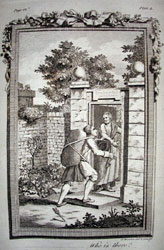 If you don't think Puritans were gloomy people in black hats who never enjoyed themselves and went on regular witch-hunts, you're in a minority. It's a good minority to be in (the Puritans weren't like that at all), but it's still a minority. Because this image has become the most popular one, Puritan writings are mostly ignored.
If you don't think Puritans were gloomy people in black hats who never enjoyed themselves and went on regular witch-hunts, you're in a minority. It's a good minority to be in (the Puritans weren't like that at all), but it's still a minority. Because this image has become the most popular one, Puritan writings are mostly ignored.
Except one. A lot of people don't realize John Bunyan was an English Puritan, but The Pilgrim's Progress is not only considered his greatest work, it's often praised as one of the best books ever written about the Christian life. Unlike the works of other Puritans (and perhaps the reason Bunyan is seldom identified with them), however, this one is also a great story.
This is NOT to suggest that the works of other Puritans aren't just as good and worthy of being read (especially anything by John Owen and Richard Baxter), just that they didn't usually write fiction. Bunyan's allegory of a Christian moving from the moment of first faith all the way to final sanctification through death is a great adventure and a great devotional.
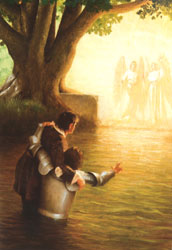 There's been a lot of misunderstanding lately about the nature of allegory. Because books like The Chronicles of Narnia by C. S. Lewis and Lilith by George MacDonald have been called "allegories," many readers assume an allegory is a story in which characters and events represent something else.
There's been a lot of misunderstanding lately about the nature of allegory. Because books like The Chronicles of Narnia by C. S. Lewis and Lilith by George MacDonald have been called "allegories," many readers assume an allegory is a story in which characters and events represent something else.
A true allegory, however, is a story in which deeper meanings are personified. In The Pilgrim's Progress, for instance, the pilgrim is named Christian while his enemies have names like Mr. Worldly Wiseman, Atheist, and Beelzebub. The difference between this story and a simple tract is that these characters live and have personalities consistent with their names.
Does this make the narrative any less exciting? By no means! When Christian fights Apollyon with his sword, it's just as entertaining as reading about King Arthur killing bad guys. What makes The Pilgrim's Progress better is that the fighting isn't just thrown in for its own sake, nor does it represent something you then have to identify.
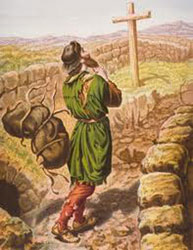 Making everything obvious wasn't Bunyan's way of insulting his audience. Far from it: he knew how sophisticated readers can be, and how easily we can read into things meaning not intended, or interpret according to whim. Having Christian literally lay down his burden at the Cross allows Bunyan to show us just how real and important the Gospel is.
Making everything obvious wasn't Bunyan's way of insulting his audience. Far from it: he knew how sophisticated readers can be, and how easily we can read into things meaning not intended, or interpret according to whim. Having Christian literally lay down his burden at the Cross allows Bunyan to show us just how real and important the Gospel is.
The reality of the Christian life (with its temptation, hardship, and hope of heaven) is Bunyan's theme, no more and no less. All who claim to follow Christ can expect the same kind of experiences Christian has in The Pilgrim's Progress, though sometimes with less clarity; this excellent book will help you stand fast against obvious and less obvious dangers alike.
 |
Review by C. Hollis Crossman
C. Hollis Crossman used to be a child. Now he is a husband and father, teaches adult Sunday school in his Presbyterian congregation, and likes weird stuff. He might be a mythical creature, but he's definitely not a centaur.Read more of his reviews here.
|
ABOUT THE EDITIONS

Click here to view an exclusive comparison chart featuring the original Pilgrim's Progress text and two modern adaptions.
Pilgrim's Progress is easy to read online in a variety of formats. Gutenberg.org offers an HTML version, as well as a Kindle file. However, if you want the traditional look and feel of a paper book, we have a variety of options for you.
The following three editions have not been abridged, even though they have been edited by different scholars.
Our Dover Thrift edition does not contain the Bible verse references that are present in many of the original editions. There are 6-9 word summaries of the paragraphs in the page margins, which are incredibly helpful for students leafing back through their copies trying to find a particular section of dialogue.
Oxford World Classics offers a paperback edition which includes a long introduction, a hefty bibliography, a chronology of Bunyan's life, and a glossary. This version contains paragraph summaries and Bible verses in the margins.
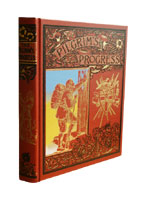 Our most beautiful version of Pilgrim's Progress is definitely John L. Dagg Publishing's embossed hardcover. It's a reprint of an 1891 edition by Charles Foster Publishing, and is smyth-sewn for durability. It contains an introduction, a biography of John Bunyan, 170 incredible detailed engravings, and a Bible reference section at the end. For hundreds of years Pilgrim's Progress has been treasured by English-speaking families, and it makes sense that you would want an heirloom edition of this wonderful story. We searched for a copy we could stand behind for a long time and this is by far the nicest we've found.
Our most beautiful version of Pilgrim's Progress is definitely John L. Dagg Publishing's embossed hardcover. It's a reprint of an 1891 edition by Charles Foster Publishing, and is smyth-sewn for durability. It contains an introduction, a biography of John Bunyan, 170 incredible detailed engravings, and a Bible reference section at the end. For hundreds of years Pilgrim's Progress has been treasured by English-speaking families, and it makes sense that you would want an heirloom edition of this wonderful story. We searched for a copy we could stand behind for a long time and this is by far the nicest we've found.
ABOUT THE ADAPTIONS
Here are two retellings for readers who don't want to read the original, but are too advanced for the kid versions...
The 1998 Pilgrim's Progress In Modern English by L. Edward Hazelbaker contains detailed indexes, author biographies, illustrations, a thorough study guide, and a link to an audio excerpts download. Hazelbaker manages to keep Bunyan's elegant 17th century tone, but avoides mere superfluity. One thing to appreciate about his rendering is the elimination of the dialogue format found in the original. Instead of chunks of text clearly labeled with the speaker's name, Hazelbaker opts for a more modern novel format. Bible references (including additions by Hazelbaker) are found in the notes after each chapter.
 James H. Thomas' 1964 version, Pilgrim's Progress in Today's English contains a few illustrations but no additional material. The Bible references are included as footnotes at the bottom of each page. Thomas keeps the original dialogue format, which makes the book seem older and more classic.
James H. Thomas' 1964 version, Pilgrim's Progress in Today's English contains a few illustrations but no additional material. The Bible references are included as footnotes at the bottom of each page. Thomas keeps the original dialogue format, which makes the book seem older and more classic.
ABOUT THE CHILDREN'S VERSIONS
Helen L. Taylor's Little Pilgrim's Progress has become something of a classic in its own right. We carry two versions of this one: first, a paperback anniversary copy full of pen-and-ink illustrations in which Christian and Christiana are portrayed as children; and second, a hardcover edition with lots of amazing illustrations by Joe Sutphin in which the characters are portrayed as animals. While these are major changes and could potentially ruin the book, Taylor (and Sutphin) executes it tastefully and remains faithful to Bunyan's tone and attitude. One thing to appreciate about this junior version is Taylor's decision to not cut the violent parts of the original story, even though Christian is a child. During a fight with Self, Christian is wounded and must stab his way to victory. At Vanity Fair, Christian watches his friend Faithful (also a child) suffer a martyr's death in a crowd of men with weapons. A Pilgrim's Progress with no real hardships is useless. Useless, because it portrays an unrealistic world where doing what is right is merely a stroll in the park, or maybe a slightly tiring hike up a hill. No real-life Christian at the end of their life would agree with this philosophy, and children a few hundred years ago would have witnessed enough death and suffering to see right through the illusion. Children can benefit from Pilgrim's Progress just as much as adults can, and it is vital that they hear sooner than later about the harships of a life dedicated to Christ.
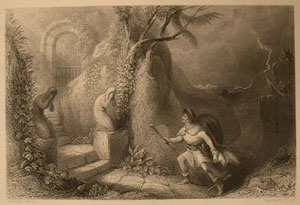 Artistically very different but still an excellent adaption, Gary D. Schmidt and Barry Moser's Pilgrim's Praise is an album by Judy Rodgers containing thirteen songs based on Pilgrim's Progress. Included are "Vanity Fair, " "Sovereign Grace" and "I Will Sing Unto the Lord." Pastor Bill Shisko of New York loved the album when he first heard it: "Pilgrim's Praise is full of sheer encouragement for Christians. Some of these songs are worthy of any hymnal. Lovers of Pilgrim's Progress will recall section after section as they musically enter the story." You can listen to excerpts of each song by clicking on the link above.
Artistically very different but still an excellent adaption, Gary D. Schmidt and Barry Moser's Pilgrim's Praise is an album by Judy Rodgers containing thirteen songs based on Pilgrim's Progress. Included are "Vanity Fair, " "Sovereign Grace" and "I Will Sing Unto the Lord." Pastor Bill Shisko of New York loved the album when he first heard it: "Pilgrim's Praise is full of sheer encouragement for Christians. Some of these songs are worthy of any hymnal. Lovers of Pilgrim's Progress will recall section after section as they musically enter the story." You can listen to excerpts of each song by clicking on the link above.
For younger kids, we carry Dangerous Journey: The Story of Pilgrim's Progress, illustrated by Alan Parry. Oliver Hunkin is responsible for the classic text, which contains no modern slang and makes no claim to trendiness. Christian and Christiana are portayed as adults. Parry's translations are somewhat cartoonish and work quite well witha story full of characters with simplistic names. It makes complete sense to have "Mr. Worldy Wiseman" portrayed as the kind of extravagantly decorated, hopelessly obese fop you'd expect to see in an 18th century British or French political cartoon. This is an excellent family-read aloud, since the illustrations will hold both the attention of adults and kids of difference ages.
Emily Fischer wrote Dangerous Journey, a comprehension guide for the Veritas Press Guide series. This guide has students make a "lift-the-flap" travel log of the journey to discuss the major themes of the Christian faith presented in the story. There are questions for every chapter--along with room to write the answers--and the solutions in the back. There are also etchings and pen-and-ink illustrations throughout.

Did you find this review helpful?